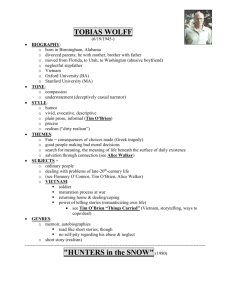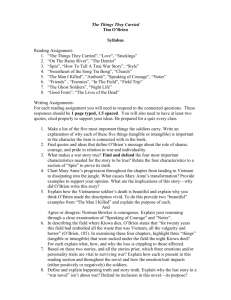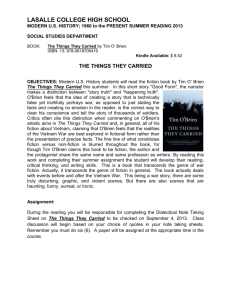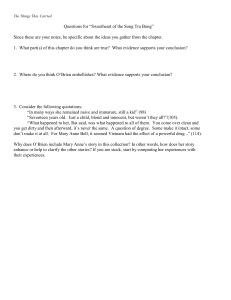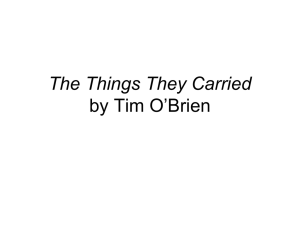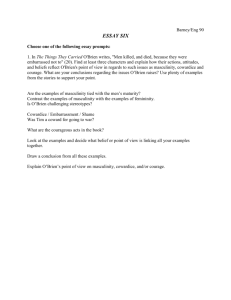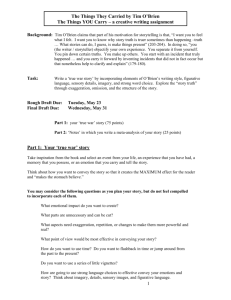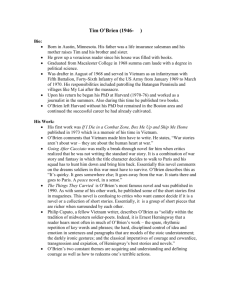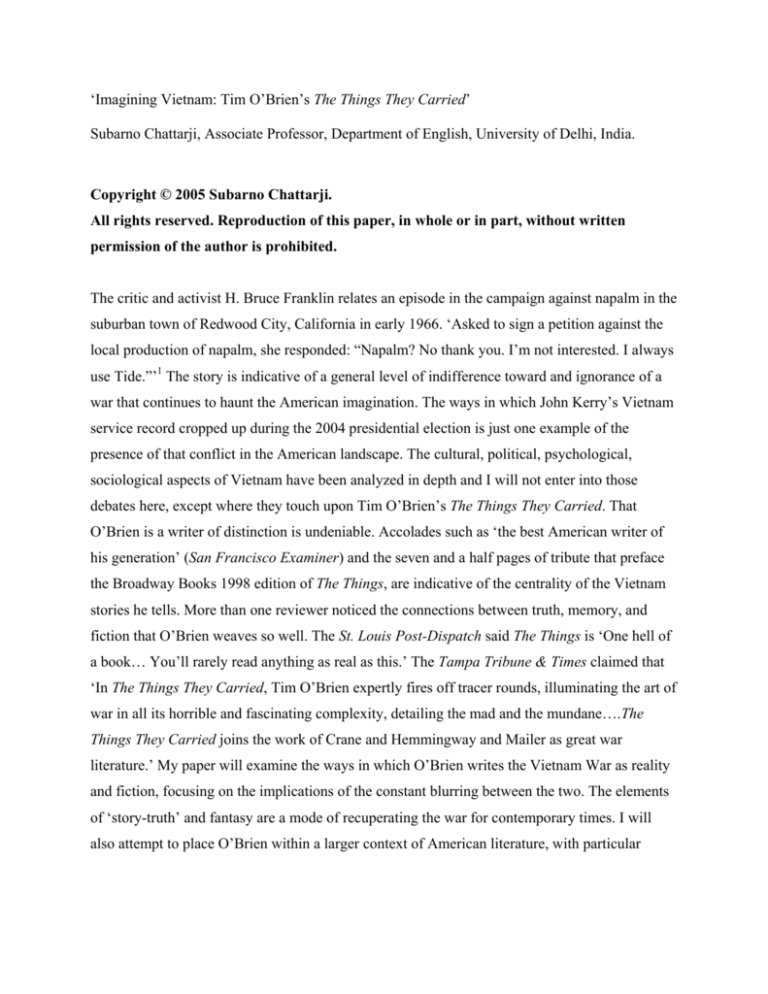
‘Imagining Vietnam: Tim O’Brien’s The Things They Carried’
Subarno Chattarji, Associate Professor, Department of English, University of Delhi, India.
Copyright © 2005 Subarno Chattarji.
All rights reserved. Reproduction of this paper, in whole or in part, without written
permission of the author is prohibited.
The critic and activist H. Bruce Franklin relates an episode in the campaign against napalm in the
suburban town of Redwood City, California in early 1966. ‘Asked to sign a petition against the
local production of napalm, she responded: “Napalm? No thank you. I’m not interested. I always
use Tide.”’1 The story is indicative of a general level of indifference toward and ignorance of a
war that continues to haunt the American imagination. The ways in which John Kerry’s Vietnam
service record cropped up during the 2004 presidential election is just one example of the
presence of that conflict in the American landscape. The cultural, political, psychological,
sociological aspects of Vietnam have been analyzed in depth and I will not enter into those
debates here, except where they touch upon Tim O’Brien’s The Things They Carried. That
O’Brien is a writer of distinction is undeniable. Accolades such as ‘the best American writer of
his generation’ (San Francisco Examiner) and the seven and a half pages of tribute that preface
the Broadway Books 1998 edition of The Things, are indicative of the centrality of the Vietnam
stories he tells. More than one reviewer noticed the connections between truth, memory, and
fiction that O’Brien weaves so well. The St. Louis Post-Dispatch said The Things is ‘One hell of
a book… You’ll rarely read anything as real as this.’ The Tampa Tribune & Times claimed that
‘In The Things They Carried, Tim O’Brien expertly fires off tracer rounds, illuminating the art of
war in all its horrible and fascinating complexity, detailing the mad and the mundane….The
Things They Carried joins the work of Crane and Hemmingway and Mailer as great war
literature.’ My paper will examine the ways in which O’Brien writes the Vietnam War as reality
and fiction, focusing on the implications of the constant blurring between the two. The elements
of ‘story-truth’ and fantasy are a mode of recuperating the war for contemporary times. I will
also attempt to place O’Brien within a larger context of American literature, with particular
reference not to the fictions of Crane, Hemingway, or Mailer but to the figure of Huckleberry
Finn.
As the newspaper reviews suggest, O’Brien is undoubtedly a war writer, with all his
works emerging from and based on the war in which he fought. In an interview in March 1990
he acknowledged the inescapable heritage of Vietnam: ‘The war made me a writer.’2 However,
he does not wish to be read purely as a war writer. In an interview in 1987 he declared: ‘I don’t
think of myself as a “war writer.” I don’t think my writing is very political.’3 Given the nature of
the Vietnam War and the centrality of that war to all of O’Brien’s writings, the disavowal of
politics is either disingenuous or naïve. In an interview with Tobey Herzog in 1997 he repeated
his rejection of the label of war writer: ‘It’s like calling Toni Morrison a black writer or
Shakespeare a king writer.’4 While such labels are reductive, O’Brien’s response reflects a desire
to move beyond the ambit of Vietnam while writing about the war and its aftermath. He wishes
to place his war experience and the writings of those experiences within a larger fictional and
cultural framework that is not defined solely as ‘war literature’. This stated desire leads, I
believe, to the constant negotiation between reality and fiction, and the impression that the
Vietnam War can be perceived in metafictional terms.
The immediate impact of The Things They Carried is based on O’Brien’s fidelity to
detail: ‘The things they carried were largely determined by necessity. Among the necessities or
near necessities were P-38 can openers, pocket knives, heat tabs, wristwatches, dog tags,
mosquito repellent, chewing gum, candy, cigarettes, salt tablets, packets of Kool-Aid, lighters,
matches, sewing kits, Military Payment Certificates, C rations, and two or three canteens of
water. Together these items weighed between 15 and 20 pounds, depending upon a man’s habits
or rate of metabolism.’5 This is the Jamesian ‘solidity of specification’ that helps create the
‘reality’ of Vietnam for readers. The catalogue not only creates a welter of detail but simulates
the weight of the things carried by the grunts. These facts are combined with the intangible and
the psychological: ‘They all carried ghosts’; ‘They shared the weight of memory’; ‘They carried
all the emotional baggage of men who might die’ (Carried, 10, 14, 21). The catalogue describes
in microcosmic terms the fighting machine of the US and is symptomatic of a culture of
production, consumption, and waste, as O’Brien indicates a little later: ‘Purely for comfort, they
would throw away rations, blow their Claymores and grenades, no matter, because by nightfall
2
the resupply choppers would arrive with more of the same, then a day or two later still more,
fresh watermelons and crates of ammunition and sunglasses and woolen sweaters – the resources
were stunning – sparklers for the Fourth of July, colored eggs for Easter – it was the great
American war chest – the fruits of science, the smokestacks, the canneries, the arsenals at
Hartford, the Minnesota forests, the machine shops, the vast fields of corn and wheat – they
carried like freight trains; […] for all the ambiguities of Vietnam, all the mysteries and
unknowns, there was at least the single abiding certainty that they would never be at a loss for
things to carry’ (Carried, 15-16). In the manner of classic satirists such as Jonathan Swift,
O’Brien relentlessly builds the structure of a catalogue to highlight the sheer absurdity of things,
the belief that things could win the war, and the yawning chasm between the US and its
opponent. The last point is specifically driven home when the belongings of a dead VC boy of
about 15 or 16 are described: ‘At the time of his death he had been carrying a pouch of rice, a
rifle, and three magazines of ammunition’ (Carried, 13). There is an element of romanticizing of
the enemy as peasant fighters with little more than revolutionary zeal in this description (and
more so in the chapter, ‘The Man I Killed’), a romantic image ably fostered by anti-war activists
such as Mary McCarthy and Susan Sontag. This portrait of saintly peasant warriors ignored not
only the military hardware and capability that the NVA possessed, but also overlooked atrocities
that they and the NLF were capable of. What is undeniable, however, is the technological gap
between the US and the Vietnamese, and the sheer volume of firepower that the US brought to
bear on a tiny country. O’Brien also hints most accurately at a cultural difference between the
two nations, one in which objects can be endlessly produced and reproduced and thrown away,
and one in which things are scarce and more precious.
O’Brien’s primary focus is on war stories, their telling, and their truth value. The chapter
‘How to Tell a True War Story’ begins: ‘This is true’ (Carried, 67). The work overall is labeled
‘a work of fiction’ and throughout we have a complex interplay between ‘fact’ and ‘fiction’.
O’Brien’s authority to tell the tale arises from the fact that he was there, he lived to tell the tale,
an authority that is evoked by narrators ranging from Ishmael in Moby Dick to Huck Finn. In the
context of the Vietnam War it is almost imperative that the narrator be a Vietnam veteran since
no one else can actually tell the truth. This is a myth that has been fostered by veterans’ writings
and testimonies and it perpetuates the idea of a closed circle of understanding and truth. As
3
Lorrie Smith observes, ‘O’Brien often depicts war as inaccessible to non veterans, creating a
storytelling loop between characters within stories that excludes the uninitiated reader and
privileges the authority of the soldier’s experience.’6 Smith’s critique is primarily concerned with
representations of masculinity in The Things They Carried, and her point about exclusivity is
important in our understanding of an underlying assumption that drives and controls the
narrative. Assuming authority, O’Brien proceeds to define the parameters of a ‘true’ war story.
‘A true war story is never moral. It does not instruct, nor encourage virtue, nor suggest models of
proper human behavior, nor restrain men from doing the things men have always done. If a story
seems moral, do not believe it. […] There is no rectitude whatsoever. There is no virtue’
(Carried, 68-69). O’Brien rejects the idea of war stories as vehicles for change and restitution,
although this is later challenged in ‘The Lives of the Dead’ where stories are seen as redemptive.
In this chapter the focus is on representations of war. ‘War is hell, but that’s not the half of it,
because war is also mystery and terror and adventure and courage and discovery and holiness
and pity and despair and longing and love. War is nasty; war is fun. War is thrilling; war is
drudgery. War makes you a man; war makes you dead’ (Carried, 80). The irreconcilable
opposites must be held together because it is in their oxymoronic togetherness that the opposing
terms articulate the ‘reality’ of war. O’Brien writes that the recollection of Curt Lemon’s death is
possible by capturing the ‘surreal seemingness, which makes the story seem untrue, but which in
fact represents the hard and exact truth as it seemed’ (Carried, 78). O’Brien grapples here with
the problem of representation, the (in)adequacy of language as a mode of conveying the
meaning, the feelings, the flavor, the terror, and the boredom of war. It is only through
inscription and re-inscription that he can hope to communicate the ‘truth’ of war, and that is one
reason the narrative is both repetitive and circular. Every assertion of ‘truth’ needs to be qualified
and re-presented if it is to be perceived as ‘authentic’. O’Brien creates an aesthetic of antisentimentalism whereby there is no morality or heroism that can be extracted from the
experience of combat. This is unexceptionable and ties in with his sense of the injustice of the
Vietnam War, which I discuss in a while.
The yoking of contraries mentioned earlier is not as value neutral as the narrative might
imply. A long passage on pages 80-81 indicates some of the problems:
It can be argued, for instance, that war is grotesque. But in truth war is also
beauty. For all its horror, you can’t help but gape at the awful majesty of combat.
4
You stare out at tracer rounds unwinding through the dark like brilliant red
ribbons. You crouch in ambush as a cool, impassive moon rises over the
nighttime paddies. You admire the fluid symmetries of troops on the move, the
harmonies of sound and shape and proportion, the great sheets of metal-fire
streaming down from a gunship, the illumination rounds, the white phosphorus,
the purply orange glow of napalm, the rocket’s red glare. It’s not pretty, exactly.
It’s astonishing. It fills the eye. It commands you. You hate it, yes, but your eyes
do not. Like a killer forest fire, like cancer under a microscope, any battle or
bombing raid or artillery barrage has the aesthetic purpose of absolute moral
indifference – a powerful, implacable beauty – and a true war story will tell the
truth about this, though the truth is ugly. (Carried, 80-81)
The irresistible beauty of combat is something that soldier-writers have testified to across wars.
In Vietnam, Robert Stone, W.D. Ehrhart, and William J. Broyles, among others, write of this
‘awful’, ‘astonishing’ spectacle. Broyles who served in Vietnam in 1969 and 1970, explained the
allure of war in terms not too dissimilar from O’Brien, in an article, ‘Why Men Love War’: ‘Part
of the love of war stems from its being an experience of great intensity; its lure is the
fundamental human passion to witness, to see things, what the Bible calls the lust of the eye and
the Marines in Vietnam called eye fucking.’7 The idea of war as fascinating spectacle has been
bolstered in the post-Vietnam era by television coverage, particularly CNN’s of the first Gulf
War: ‘The skies are illuminated over Baghdad.’ As in descriptions by other writers, O’Brien
projects war as a disembodied presence with a life of its own, where instruments of death such as
white phosphorus and napalm are magically transformed into morally indifferent objects of
beauty. O’Brien is astute enough to acknowledge that the recognition of such destruction as
‘beautiful’ is in itself an ugly truth, but the telling of that truth is justified on the basis of its truth
function. Ugly ‘truths’ such as the fascination that war begets must be expressed, yet in their
expression such ‘truths’ tend to aestheticize and domesticate war. The ‘absolute moral
indifference’ that O’Brien attributes to artillery barrages or bombing raids is only tenable if there
is no human agency behind those barrages or raids. Since, alas, there is always human agency
behind war, and since, as O’Brien portrays so eloquently, war maims and kills, it is difficult to
maintain a stance of aesthetic or moral distance when these monstrosities are unleashed. In
articulating an alternative moral paradigm O’Brien seems to perpetuate a mythic fascination with
the horrors of war, of combat as a crucible for growth toward manhood and maturity.
5
Underlying this valorization of participating and witnessing war is O’Brien’s larger
concern with truth-telling and stories. The intertwining of ‘fact’ and ‘fiction’ is a narrative
strategy that all critics of O’Brien note. Tobey C. Herzog writes: ‘O’Brien’s assertion of a
purportedly factual story or piece of information later contradicted by his confession of its fictive
nature is his method for effectively introducing listeners to the complex intermingling of facts,
history, fiction, truth, lies, memory, and imagination underlying all of his writings.’8 The
interplay of fact, fiction, memory, and imagination is crucial in literary representations of the
Vietnam War. In contexts where language itself was debased and inadequate as a mode of
representing the horrors of combat, a purely ‘factual’ representation might seem incomplete.
Hence the need for the commingling of fact, fiction, and metafiction. This need explains
O’Brien’s insistence on the importance of story telling in his writings and interviews. In ‘Spin’
O’Brien writes: ‘Stories are for joining the past to the future. […] Stories are for eternity, when
memory is erased, when there is nothing to remember except the story’ (Carried, 38). In ‘Good
Form’: ‘What stories can do, I guess, is make things present’ (Carried, 180). In ‘The Lives of the
Dead’: ‘The thing about a story is that you dream it as you tell it, hoping that others might then
dream along with you, and in this way memory and imagination and language combine to make
spirits in the head’ (Carried, 230). In an interview O’Brien stated: ‘I’m a believer in the power of
stories, whether they’re true, or embellished, and exaggerated, or utterly made up. A good story
has a power… that transcends the question of factuality or actuality.’9 Stories are a mode of
recuperating the past and they are seen as redemptive in the way in which the boy Timmy
resuscitates Linda and through that resurrection salvages the life of the narrator Tim O’Brien.
There is a touching faith in the power of the word, the story well told that adds value to the
narration. Steven Kaplan says that The Things ‘is O’Brien’s expression of his love of storytelling
as an act that can wrestle tolerable and meaningful truths from even the most horrible events’.10
Whether it is the actuality of combat and death in Vietnam or the death of Linda, narrative seems
to be a mode of retelling and thereby healing. Much of the writings by Vietnam veterans
originates and perhaps performs a therapeutic function and while one may debate the value of
writing as psychological catharsis, one is willing to accept the premise of stories as regenerative.
A problem arises, however, when narrative is seen as a purely performative act, a game
with endless possibilities. The stress on ambiguity and uncertainty in Vietnam War stories
6
reflects part of the actuality of combat. In ‘Ghost Soldiers’ O’Brien indicates the sense of a
haunted landscape in which the Americans were aliens: ‘It was ghost country, and Charlie Cong
was the main ghost. The way he came out at night. How you never really saw him, just thought
you did. Almost magical – appearing, disappearing. He could blend with the land, changing
form, becoming trees and grass. He could levitate. He could fly. He could pass through barbed
wire and melt away like ice and creep up on you without sound or footsteps’ (Carried, 202). One
has only to read accounts and stories by ‘Charlie Cong’ to realize that there was nothing
‘magical’ in his existence, but the stereotypical representation of the enemy creates a mimesis of
Vietnam as a phantasmagoric game, with no definite ‘facts’. The stress on ambiguity and
uncertainty in Vietnam overlooks unambiguous facts such as the deaths of American soldiers and
Vietnamese soldiers and civilians, of the depredations wrought by napalm or cluster bombs, of
the NLF assassinating village chiefs in south Vietnam, and the list can go on. O’Brien indicates
some of this reality in the graphic, multiple descriptions of the deaths of Curt Lemon and Kiowa.
Yet in asserting the value of storytelling as a means of ameliorating the horrors of Vietnam, he
creates an overall mythic structure of love, comradeship, and forgetfulness in the very process of
recovering that horror: ‘You become part of a tribe and you share the same blood – you give it
together, you take it together’ (Carried, 192). Any outsider who is not a part of this ‘tribe’ is just
a ‘dumb cooze’ (Carried, 68) who cannot really comprehend the story. Nevertheless stories are
vital and O’Brien reiterates the overwhelming power of the story in an interview: ‘I think two
hundred years, seven hundred years, a thousand years from now, when Vietnam is filled with
condominiums… the experience of Vietnam – all the facts – will be gone. Who knows, a
thousand years from now the facts will disappear – bit by bit – and all that we’ll be left with are
stories.’11 One need not wait as long as O’Brien predicts for the facts to disappear, or be
rewritten, or distorted. As Bruce Franklin and others have pointed out, the Vietnam War has been
effectively rewritten in American politics, popular culture, and imagination so that, in a sense, all
that we’re left with are stories. O’Brien’s stories have greater integrity and truth than the ones
told by Hollywood or Washington, but there is every danger that the privileging of story qua
story will contribute to the further dehistoricizing of the Vietnam conflict. To perceive Vietnam
purely or largely in terms of ambiguity, mystery, and endlessly multiplying narratives is to fall
into a typically post-modernist trap. The problem of ‘facticity’ in representations of Vietnam
gives rise to a post-modern illusion of the free play of meaning whereby any set of ‘facts’ can be
7
wheeled out to prove or disprove any ideological or political view of the war. The way in which
‘facts’ are wielded can alter perceptions of the conflict. For example, reading Al Santoli’s oral
history of the Vietnam War, To Bear Any Burden, one might be convinced that every
Vietnamese hated communists and communism, and that the US involvement was a glorious, if
slightly muddled, intervention. Santoli’s strategy is to include north Vietnamese defectors and
anti-war protestors, thereby creating a sense of pluralism. This kind of all-encompassing
pluralism, as Fredric Jameson points out, is dubious: ‘Pluralism is one thing when it stands for
the coexistence of methods and interpretations in the intellectual and academic marketplace, but
quite another when it is taken as a proposition about the infinity of possible meanings and
methods and their ultimate equivalence with and substitutability with one another.’12 This is
arguably a ubiquitous condition, but exacerbated in the context of Vietnam where disembodied
facts are bandied about without any moral discrimination, and any set of facts can be
counterbalanced by another. One person’s fact is another’s fiction, and the war and its aftermath
can be mired in post-modern ambiguity and free-play of meaning. ‘As Jim Neilson has cogently
argued in Warring Fictions: Cultural Politics and the Vietnam War Narrative, the widespread
intellectual perception of the Vietnam experience as too alien to be comprehended has helped to
establish a canon of Vietnam War literature that enshrines indeterminacy, incoherence,
ambiguities, strangeness, and unknowability, with critics exalting Michael Herr’s Dispatches as
the quintessential truth about the war.’13 Several critics have placed O’Brien within this mold
because he ‘spins a complex dialectic between what he calls “story-truth” and happening-truth”’
and they ‘have interpreted his fiction as validating their own view of the Vietnam War as
unknowable or crazy or “unreal”’.14 From the combat soldier’s point of view Vietnam was a
mystery or unknowable simply because he was not equipped with any knowledge of the country
and its people. Stunning ignorance coalesced with the fear that combat engenders to create the
sense of an inscrutable enemy. In purely epistemic terms the problem seems to be not whether
Vietnam was/is unknowable, but the extent to which fear and ignorance made it so. O’Brien’s
fiction-memoir-autobiography interface does not steer clear of ugly, ignoble truths, but there is
the discomfiting possibility that endless interpretations are not only possible but desirable,
because stories are all that we have to comprehend the war.
8
To conclude here would be to place O’Brien among the legion of dubious writers on the
Vietnam War and that would create an incomplete picture of a complex writer. As in his stories,
there are contraries that need to be taken into account. Despite the enthusiastic embrace of postmodern and conservative critics, O’Brien himself has attacked the interpretations that see the
Vietnam War as unknowable and crazy. ‘For me, Vietnam wasn’t an unreal experience, it wasn’t
absurd. It was a cold-blooded, calculated war,’ he said in an interview in 1984.15 In a later
interview with Tobey Herzog O’Brien expressed his sense of personal moral responsibility: ‘In
my case I committed an act of unpardonable cowardice and evil. I went to a war that I believed
was wrong and participated in it actively. I pulled the trigger. I was there. And by being there I
am guilty.’16 This awareness distinguishes O’Brien from veteran writers such as Philip Caputo or
W.D. Ehrhart who went to Vietnam believing they were fighting for God and country and were
disillusioned only when they experienced the war. This pre-war knowledge and the choices it
involved are expressed in the chapter ‘On the Rainy River’.
O’Brien’s discomfort with the war is expressed clearly: ‘In the June of 1968, a month
after graduating from Macalester College, I was drafted to fight a war I hated. I was twenty-one
years old. Young, yes, and politically naïve, but even so the American war in Vietnam seemed to
me wrong. Certain blood was being shed for uncertain reasons’ (Carried, 40). The story of this
chapter has been narrated earlier by O’Brien in his memoir, If I Die in a Combat Zone, and its
repetition is testimony to the intensity of his conviction. The basis of opposition is his belief that
the war was unjust: ‘It was my view then, and still is, that you don’t make war without knowing
why. Knowledge, of course, is always imperfect, but it seemed to me that when a nation goes to
war it must have reasonable confidence in the justice and imperative of its cause. You can’t fix
your mistake. Once people are dead, you can’t make them undead’ (Carried, 40-41). One can
hardly disagree with these statements, but O’Brien seems to overlook or forget that US
Presidents and policy makers were confident of the justice and imperatives of their cause, that
they believed the domino theory and that only the US could save the world for democracy. Of
course, as The Pentagon Papers and other documents subsequently proved, there were clear
elements of mendacity, but those lies arose out of a core belief in the justice of the US cause.
Even retrospective statements testify to the conviction of the people who made and prosecuted
the war. Here are just two examples, the first from Richard Nixon’s No More Vietnams and the
9
second from Robert McNamara. Nixon wrote: ‘Today, after Communist governments have killed
over a half million Vietnamese and over 2 million Cambodians, the conclusive moral judgment
has been rendered on our effort to save Cambodia and South Vietnam: We have never fought in
a more moral cause.’17 McNamara acknowledges errors and his sense of unease at the way the
war was conducted, but he concludes In Retrospect with a reiteration of basic goals: ‘Let me be
simple and direct – I want to be clearly understood: the United States of America fought in
Vietnam for eight years for what it believed to be good and honest reasons. By such actions,
administrations of both parties sought to protect our security, prevent the spread of totalitarian
Communism, and promote individual freedom and political democracy.’18 The convictions
expressed during and after the war by the Nixons and the McNamaras are open to question but
they were deeply held and O’Brien seems to ignore that.
‘On the Rainy River’ is a crucial chapter, however, because it encapsulates the dilemmas
of choice and conscience so central to the American imagination. In an interview with Steven
Kaplan in 1991 O’Brien expressed his belief that all great fiction explores moral quandaries and
portrays characters who are confronted with making a difficult choice: ‘The reason choice seems
to me important as a word and as a way for me to think about stories is that it involves values.
It’s most interesting when the choices involve things of equally compelling value.’19 Thus the
narrator O’Brien grapples with two kinds of fear when contemplating escape to Canada: ‘I feared
the war but I also feared exile’ (Carried, 44). Finally it is the fear of exile and shame that
triumph: ‘What it came down to, stupidly, was a sense of shame. […] I did not want people to
think badly of me. […] I was ashamed of my conscience, ashamed to be doing the right thing’
(Carried, 52). This searing confession concludes with a summation of the self that continues to
haunt the narrator: ‘I was a coward. I went to war’ (Carried, 61). At an obvious level this
statement overturns heroic models of manhood and courage nurtured in the crucible of war.
William Broyles’s essay, ‘Why Men Love War’ is just one example of the generic glorification
of war that O’Brien questions. In O’Brien’s narrative cowardice is related to a state of being
where conscience and morality fail to influence and shape action. In his interview with Herzog
O’Brien declared that all individuals have ‘the possibility of action, virtuous action, coming out
of a desire for pure virtue, the world notwithstanding’.20 In referring to his conscience and fear of
social obloquy O’Brien indicates that it is precisely this possibility of ‘virtuous action’ ‘the world
10
notwithstanding’ that has been rejected. In articulating that rejection and failure O’Brien ceases
to be only a war writer and reflects on quintessentially American themes of choice, morality, and
the endless possibility of fashioning oneself anew. The last possibility animates the American
imagination from the Pilgrim Fathers to Walt Whitman, from Huck Finn to The Great Gatsby. I
would like to conclude with a few comments on the Huckleberry Finn paradigm and how
O’Brien taps into a cultural, imaginary reservoir to express his moral quandaries in a time of war.
In Mark Twain’s The Adventures of Huckleberry Finn, there are two episodes when Huck
faces the ‘most interesting’ of ‘choices [which] involve things of equally compelling value’. The
first is in Chapter 16 when he lies to the slave hunters to save Jim’s freedom. The second more
extended and significant conflict occurs in Chapter 31, when he reflects on the consequences of
helping a runaway slave. ‘It would get all around, that Huck Finn helped a nigger to get his
freedom; and if I was to ever see anybody from that town again, I’d be ready to get down and
lick his boots for shame. […] The more I studied about this, the more my conscience went to
grinding me, and the more wicked and low-down and ornery I got to feeling. And at last, when it
hit me all of a sudden that here was the plain hand of Providence slapping me in the face and
letting me know my wickedness was being watched all the time from up there in heaven, whilst I
was stealing a poor old woman’s nigger that hadn’t ever done me no harm, […].’21 While Huck
had set himself in opposition to the ‘sivilizing’ mission of the Widow Douglas he believed that
helping Jim escape was a humane thing to do. However, the extent to which Huck has
internalized the dominant ideology of his society is perceptible in his sense of remorse and sin at
‘stealing a poor old woman’s nigger’. This is his socialized conscience that grinds him and leads
him to write a note to the widow letting her know the whereabouts of Jim. After writing the note
Huck says he ‘felt good and all washed clean of sin for the first time I had ever felt so in my life,
and I knowed I could pray now’ (Finn, 234). Then Huck recollects the journey that he and Jim
have shared: ‘I see Jim before me, all the time, in the day, and in the night-time, sometimes
moonlight, sometimes storms, and we a floating along, talking, and singing, and laughing’ (Finn,
235). His recollections lead him back to the message he has written and this is the moment of
reckoning:
I was a trembling, because I’d got to decide, forever, betwixt two things, and I
knowed it. I studied a minute, sort of holding my breath, and then says to myself:
“All right, then, I’ll go to hell” – and tore it up.
11
It was awful thoughts, and awful words, but they was said. And I let them stay
said; and never thought no more about reforming. (Finn, 235)
Huck Finn rejects the morality of his times that justifies the dehumanizing institution of slavery
and overturns moral paradigms; it is better to go to hell to save a fellow human being. As John
Seelye puts it, ‘In declaring himself against the laws of man Huck becomes an outlaw, but he is
in truth an avatar of the higher laws of humanity, beyond the reach of society’s often unfair rules,
his raft a dwelling reminiscent of Natty Bumpo’s cabin in The Pioneers or the hut at Walden
Pond, being a sanctuary of both sanity and sanctity.’22 The sanctuaries that Seelye describes are
temporary ones but they represent crucial alternatives, territories of conscience in times of
injustice and strife.
In his hallucinatory vision list on pages 58 and 59 O’Brien mentions Huck Finn and the
inclusion is a deliberate one in the context of Huck’s struggle with his conscience. Huck’s
decision to protect Jim – ‘“All right, then, I’ll go to hell”’ – is a decision of conscience and
courage, as opposed to O’Brien’s one to go to war: ‘I was ashamed of my conscience, ashamed
to be doing the right thing’; ‘I was a coward. I went to war’ (Carried, 52, 61). While overturning
the heroic paradigm of war, O’Brien distinctly highlights his inability to do ‘the right thing’.
Despite the realistic improbability of a 12-year-old white boy helping a slave escape in the
1840s, Huck is an iconic figure of anti-authoritarianism, the drive for freedom that animates a
part of the American imagination. Huck always has the option of ‘light[ing] out for the Territory’
(Finn, 321). That imaginative space in O’Brien’s narrative has now shrunk to a choice between a
shaming exile in Canada and a morally dubious war in a distant land, fought in the name of
ideals that were betrayed from the outset. The Vietnam War lead to a constriction of choices and
moral possibilities in much the same way as slavery desensitized and corrupted an entire society.
John Balaban, a conscientious objector and poet of the Vietnam era, concludes his poem ‘After
Our War’ with the following lines:
After the war, with such Cheshire cats grinning in our trees,
will the ancient tales still tell us new truths?
Will the myriad world surrender new metaphor?
After our war, how will love speak?23
12
Perhaps stories are a mode of restoring the worlds of metaphor, truth, and love shattered by the
Vietnam War. As O’Brien writes: ‘The thing about a story is that you dream it as you tell it,
hoping that others might then dream along with you, and in this way memory and imagination
and language combine to make spirits in the head’ (Carried, 230).
1
H. Bruce Franklin, Vietnam & Other American Fantasies (Amherst: University of Massachusetts Press, 2000), 71.
Gail Caldwell, ‘Staying True to Vietnam,’ Boston Globe (29 March 1990): 75.
3
Judith Slater, ‘An Interview with Tim O’Brien,’ The Short Story Review, Vol. 4, No. 2, Spring 1987: 1, 4-5.
4
Tobey C. Herzog, Tim O’Brien (New York: Twayne Publishers, 1997), 23.
5
Tim O’Brien, The Things They Carried (New York: Broadway Books, 1998), 2. All subsequent references to the
text are indicated as Carried after the citation.
6
Lorrie Smith, ‘“The Things Men Do”: The Gendered Subtext in Tim O’Brien’s Esquire Stories,’ Critique, Fall
1994, Vol. XXXVI, No. 1: 16-40.
7
William J. Broyles Jr., ‘Why Men Love War,’ in Walter Capps (ed.), The Vietnam Reader (New York and London:
Routledge, 1990), 71.
8
Herzog, Tim O’Brien, 2.
9
Cited in Maria S. Bonn, ‘Can Stories Save Us? Tim O’Brien and the Efficacy of the Text,’ Critique, Fall 1994,
Vol. XXXVI, No. 1: 2-15.
10
Steven Kaplan, Understanding Tim O’Brien (Columbia, SC: University of South Carolina Press, 1995), 186-187.
11
Cited in Kaplan, Understanding Tim O’Brien from Timothy Lomperis, ‘Reading the Wind’: The Literature of the
Vietnam War (Durham, NC: Duke University Press), 10.
12
Fredric Jameson, The Political Unconscious (London: Methuen & Co. Ltd., 1987), 31.
13
Franklin, Vietnam & Other American Fantasies, 32.
14
Ibid., 35.
15
Eric James Schroeder, ‘Two Interviews: Talks with Tim O’Brien and Robert Stone,’ Modern Fiction Studies Vol.
30, No. 1 (Spring 1984): 146.
16
Herzog, Tim O’Brien, 14.
17
Richard M. Nixon, No More Vietnams (London: W.H. Allen, 1986), 209.
18
Robert S. McNamara, In Retrospect: The Tragedy and Lessons of Vietnam, with Brian Van De Mark (New York:
Times Books, 1995), 333.
19
Steven Kaplan, ‘An Interview with Tim O’Brien,’ Missouri Review 14.3 (1991): 108.
20
Herzog, Tim O’Brien, 32.
21
Mark Twain, The Adventures of Huckleberry Finn, edited with an introduction by John Seelye (1884; New York:
Penguin Books, 1986), 233. All subsequent references to the text are indicated as Finn after the citation.
22
John Seelye, ‘Introduction’ The Adventures of Huckleberry Finn, xxv.
23
John Balaban, ‘After Our War,’ Locusts at the Edge of Summer: New and Selected Poems (Washington: Copper
Canyon Press, 1997), 41.
2
13

